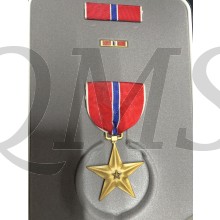Medaille US Army Bronze Star in doos (Bronze Star medal with baton boxed)
The Bronze Star Medal is the fourth-highest individual military award and the ninth-highest by order of precedence in the US Military. It may be awarded for acts of heroism, acts of merit, or meritorious service in a combat zone. When awarded for acts of heroism, the medal is awarded with the "V" device.
The medal is sometimes referred to as the Bronze Star. Foreign soldiers, as well as officers from the other federal uniformed services are also eligible to receive the decoration when serving with or alongside a service branch of the United States Armed Forces.
The Bronze Star Medal was established by Executive Order 9419, 4 February 1944 (superseded by Executive Order 11046, 24 August 1962, as amended by Executive Order 13286, 28 February 2003).
The Bronze Star Medal may be awarded by the Secretary of a military department or the Secretary of Homeland Security with regard to the Coast Guard when not operating as a service in the Navy, or by such military commanders, or other appropriate officers as the Secretary concerned may designate, to any person who, while serving in any capacity in or with the Army, Navy, Marine Corps, Air Force, or Coast Guard of the United States, after 6 December 1941, distinguishes, or has distinguished, herself or himself by heroic or meritorious achievement or service, not involving participation in aerial flight—
- (a) while engaged in an action against an enemy of the United States;
- (b) while engaged in military operations involving conflict with an opposing foreign force; or
- (c) while serving with friendly foreign forces engaged in an armed conflict against an opposing armed force in which the United States is not a belligerent party.
The acts of heroism are of a lesser degree than required for the award of the Silver Star. The acts of merit or acts of valor must be less than that required for the Legion of Merit but must nevertheless have been meritorious and accomplished with distinction. The Bronze Star Medal is awarded only to service members in combat who are receiving imminent danger pay.
The Bronze Star Medal (without the "V" device) may be awarded to each member of the Armed Forces of the United States who, after 6 December 1941, was cited in orders or awarded a certificate for exemplary conduct in ground combat against an armed enemy between 7 December 1941 and 2 September 1945. For this purpose, the US Army'sCombat Infantryman Badge or Combat Medical Badge award is considered as a citation in orders.


